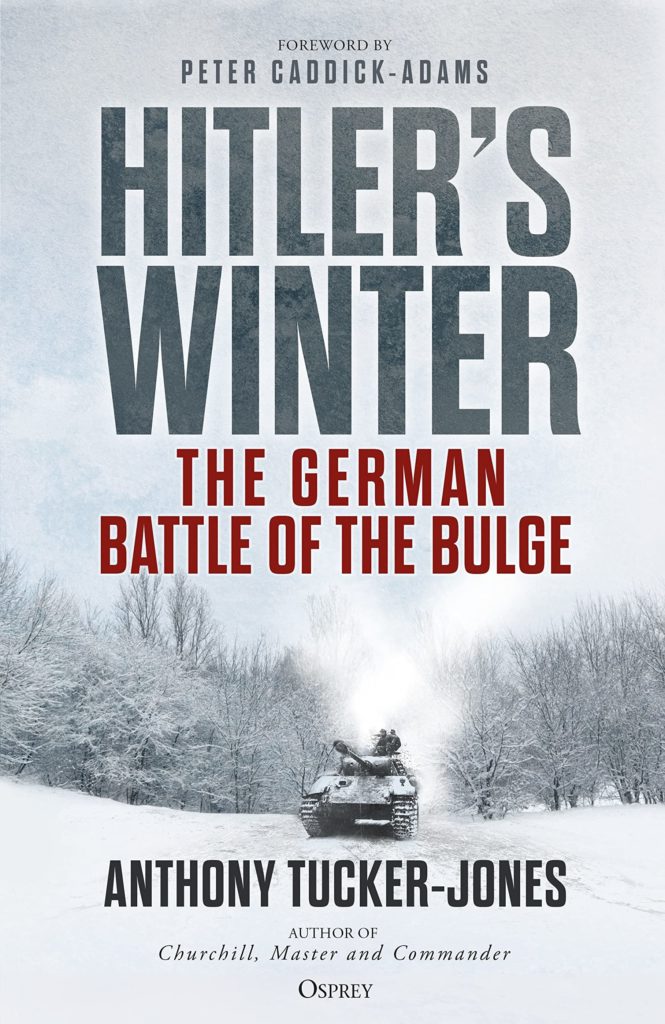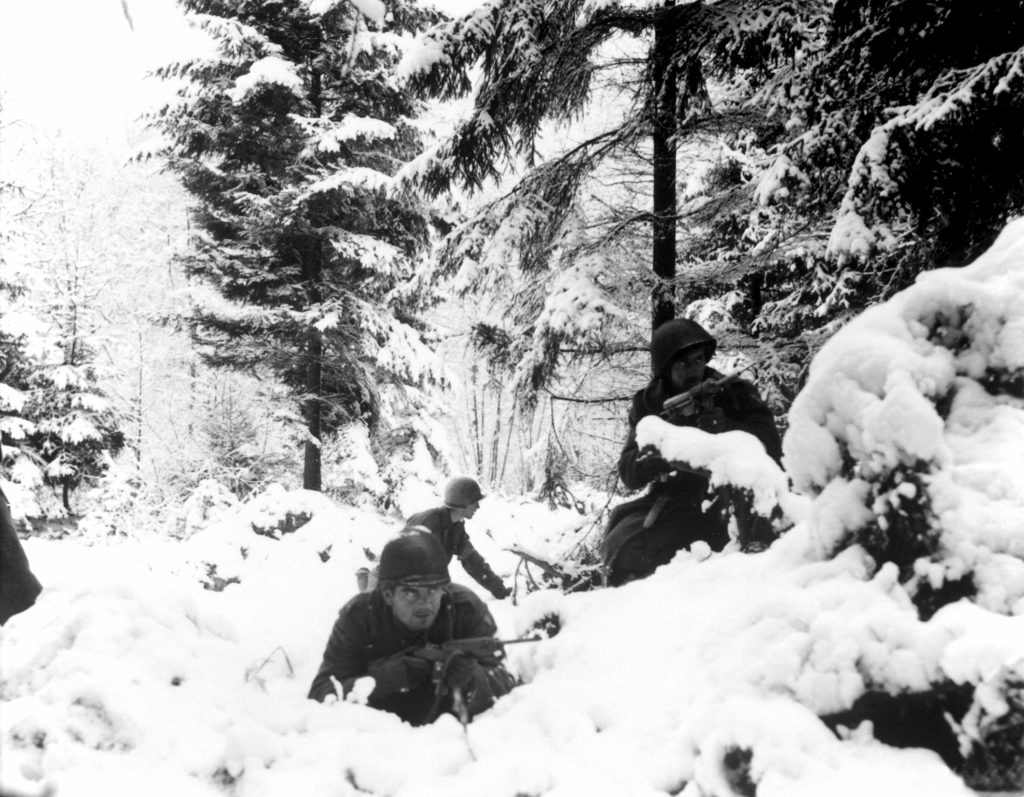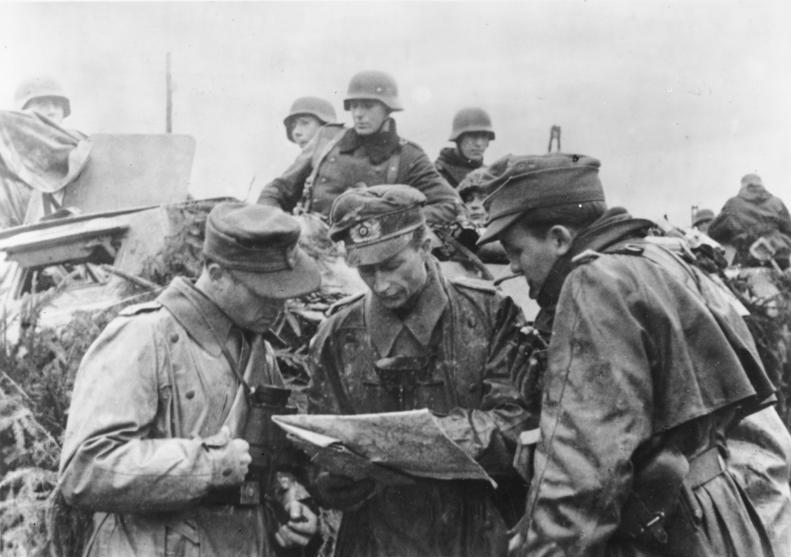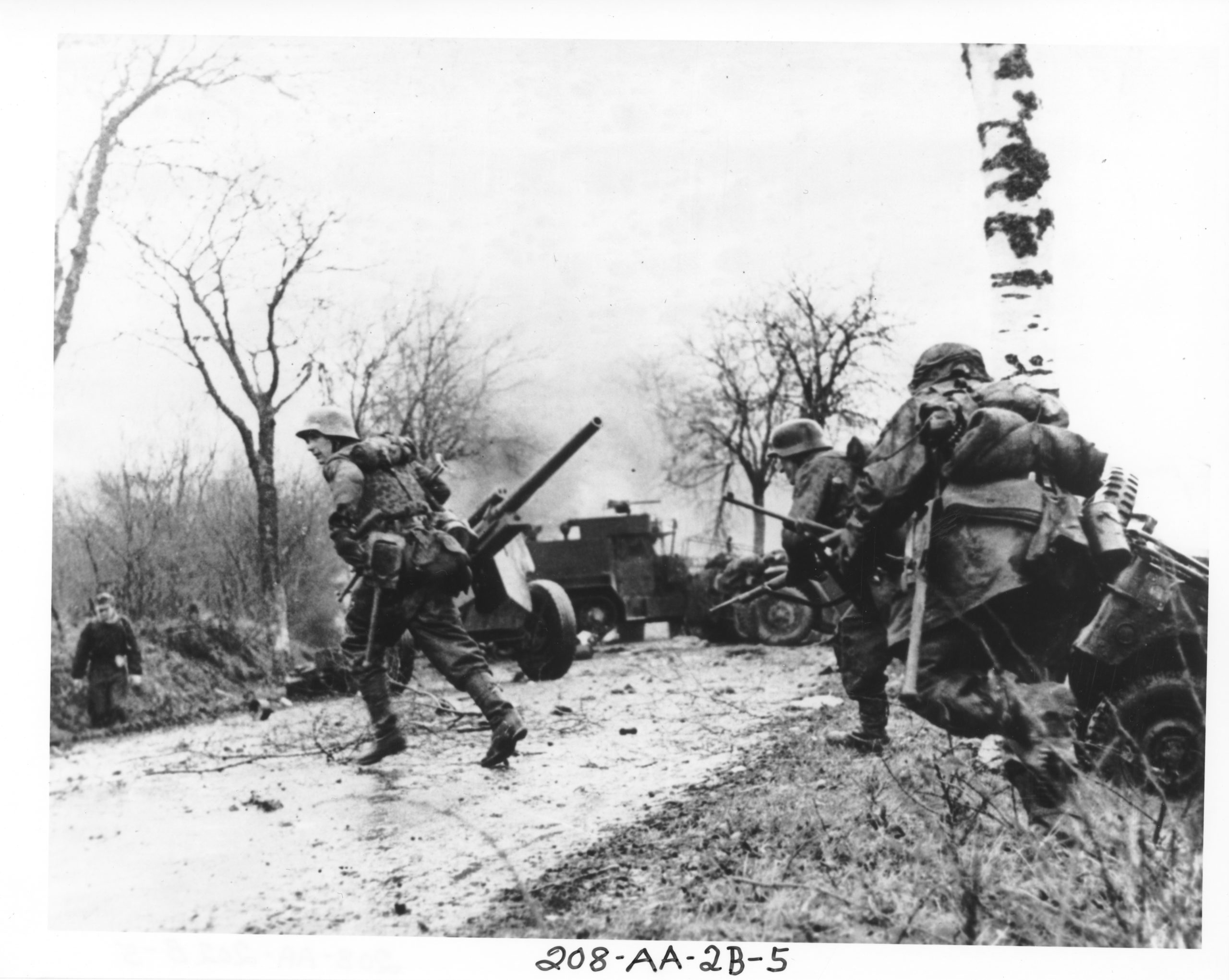The acclaimed historian and History of War contributor discusses his latest book, which focuses on the Battle of the Bulge, the Third Reich’s last bloody roll of the dice in the winter of 1944-5.
Below you’ll find a FREE 10-page preview of Anthony’s new book to download.

Why did you choose to focus on the German perspective of the battle?
Anthony Tucker-Jones: The German perspective always seemed far more exciting and intriguing to me. What made Hitler risk everything with that last throw of the dice? Many years ago I wrote a book on the battle for Falaise in Normandy from the viewpoint of the panzer divisions. Hitler’s Ardennes offensive was a direct result of their escape from the Falaise pocket. Although they lost all their panzers over 90,000 panzertruppen got away to fight another day. The Battle of the Bulge as it became known has remained a source of public fascination ever since the terrible 1960s movie of the same name. Most studies though tend to focus on the Allied response, particularly the heroic American defence of Bastogne and General Patton dramatically riding to the rescue.
What people don’t realise is that Hitler launched four very different operations on the Western Front in the winter of 1944-45 and I was keen to explore how these all fitted together. They consisted of the ground offensive in the Ardennes with Antwerp as its goal; the massed air offensive against Allied air fields in northern Europe; the V-weapons offensive against Antwerp and the offensive in the Alsace that was intended to recapture Strasbourg. These are what really informed my title Hitler’s Winter. Furthermore, I was fascinated by the special forces operations conducted in the Ardennes. There was Otto Skorzeny’s 150th Panzer Brigade masquerading as Americans, plus his commandos again disguised as Americans and the extremely ill-fated airborne operation led by von der Heydte.
In your view did the Waffen-SS and German Army generals involved in the Ardennes offensive really believe the attack would succeed?
ATJ: Post-war debriefs with the German generals showed that most of them were against it. My suspicion was that their objections were made with the benefit of hindsight and as a deliberate ploy to distance themselves from Hitler and the Nazi Party. General Sepp Dietrich was particularly guilty of such a move as he had been one of Hitler’s right-hand men from the very beginning. However, once I began to research things more deeply, I began to appreciate that Hitler’s generals really were opposed from the very start. They assessed what Hitler was proposing was simply too ambitious. They knew even if by some miracle they reached Antwerp they simply did not have the resources to hold it.
Hitler had a number of other options on the table in late 1944, none of which were as risky as his Ardennes gamble. General Heinz Guderian, who was the German Chief of Staff by this stage, felt Hitler should concentrate all his resources defending the Rhine and the Oder. In particularly defence of the latter was vital to hold the ever encroaching Red Army at bay. In the west, other than sitting on the Rhine, Hitler had what was dubbed the small and large solutions. The former envisaged a modest operation against the American breakthrough at the Germany city of Aachen, which could nip off the American bulge in the front line. The latter was a full-blown dash for Antwerp in order to deny the vital docks to the Allied war effort and to split the British and American armies.
Was the Wehrmacht capable of achieving any sort of victory in the West at this point in the war?
ATJ: Yes, the Wehrmacht was most certainly capable of achieving a limited victory in the West. Albert Speer’s efforts, as Nazi Munitions Minister, to rejuvenate the German armies after their series of catastrophic defeats on the Eastern and Western Fronts a well as in North Africa, was nothing short of a miracle. All the panzer units that escaped Normandy were painstakingly re-equipped. Reichsführer Heinrich Himmler, who was in charge of the Replacement Army, created all these new infantry units known as Volksgrenadier Divisions. The upshot was that Hitler had two very powerful panzer armies on the Western Front by the winter of ’44 capable of delivering a serious blow to the allies.
Likewise, the Luftwaffe was still a force to be reckoned with. It had all these jet fighter and bomber programmes underway that offered it a new qualitative edge over the Allies. The problem was that none of them were really ready by the end of ‘44. Nevertheless, the Luftwaffe was keen to deliver a knockout blow against the Allies, but its preferred target was America’s bomber fleet. It was hoped if they shot down enough aircraft in one go this would cause the Americans to pause with their relentless daylight raids.

The Ardennes was the Wehrmacht’s first large scale winter offensive of the war, did its inexperience at that level make a big difference?
ATJ: Most definitely. By the close of ‘44 the Wehrmacht were absolute masters of defensive warfare. They had escaped the British and Americans in France then restored the front and had held the advancing Red Army before Warsaw. In Italy their defence denied Rome to the Allies until June 1944. In contrast its last major offensive had been in the summer of 1943 at Kursk that had ended in defeat. This had destroyed Hitler’s remaining strategic offensive power. In the winter of ‘43 the Wehrmacht launched a winter offensive to relieve the German 6th Army trapped at Stalingrad. It had been conducted with insufficient strength and in the most appalling weather conditions. It also ended in failure and 6th Army was forced to capitulate.
The Germans main problem with their Ardennes offensive was time. They simply did not have enough time to plan and prepare adequately. It essentially turned into a rushed job. The special operations had just a matter of weeks to get ready. Both Skorzeny and von der Heydte’s forces were woefully small and ill-equipped. The panzer forces did not have the opportunity to map their routes. Furthermore, the American and British armies that the German assault force would have to fight were vastly different to the forces it encountered in 1940. Hitler was gambling there would be two weeks of bad weather that would ground the Allied air forces and allow him to advance rapidly using the element of surprise.
Should von Manteuffel and his army been given the lead role in the Ardennes rather than Sepp Dietrich and his?
ATJ: The challenge that the 5th and 6th Panzer armies had, under von Manteuffel and Sepp Dietrich respectively, was that they were fighting on a too narrow frontage. Dietrich’s army in the north, with all the veteran SS-panzer divisions, was nearest to Liege on the Meuse and therefore had a shorter line of advance to Antwerp. However, the Americans on the German northern shoulder held and as a result Dietrich and von Manteuffel forces converged and found themselves using the same roads, the results were delays and chaos. Furthermore, General Brandenberger’s 7th Army to the south was too weak to keep the Americans pinned down on the southern shoulder of the German break through. This meant Patton was able to rapidly reach Bastogne.
Why was holding Bastogne so important for the Allies?
ATJ: The town of Bastogne in military terms represented a very dangerous choke point. Both the Germans and the Americans knew that it was a vital communications hub dominating all the major roads in the Ardennes. The Americans though beat the Germans to it and held onto Bastogne. The Germans tried to overwhelm the garrison but did not have the strength with which to do so, also they then had to fend off General Patton cutting his way north to the town. The bitter fighting for Bastogne became an unwanted distraction for the Germans and derailed their tight time table even more. Once the weather cleared the Americans were able to resupply Bastogne by air and attack the exposed German ground forces. Patton’s arrival meant the Germans had to fight on multiple fronts and were unable to sever his relief corridor.
Back in 1940 the German Army had successfully navigated the Ardennes region to land a killer blow against the French, why couldn’t it do the same in 1944?
ATJ: Hitler’s Blitzkrieg in 1940 easily sliced through French defences in the Ardennes. At the time everyone thought such a move was impossible because of the mountainous and forested terrain. Even respected British military thinker Basil Liddell Hart in his book The Defence of Britain concluded the year before that large scale operations in that area were impossible. General Heinz Guderian, the father of Hitler’s panzer force, thought otherwise, he believed armour could move through the rough countryside. The dense woodlands would permit his panzers to move secretly and then break out into the flat land beyond. Guderian soon learned on 10 May 1940 that his advance was more about traffic control than fighting. The steep slopes, twisting roads, dense woods and inadequate bridges all made life very difficult. Nonetheless, he pulled it off.
In ‘44 the Germans were operating on a much narrower frontage involving just two armies and in the winter, whereas in 1940 their assault involved five in the springtime. During the latter German thrusts were also made north of the Ardennes toward Rotterdam and Maastricht, which neutralised both Belgium and the Netherlands. Notably Guderian struck southwest to Sedan to unhinge French defences and not north to Antwerp. The poor roads, lack of bridging equipment, critical fuel shortages and bad weather thwarted Dietrich and von Manteuffel’s advance as much as American resistance.

Did any German senior commander distinguish themselves during the Ardennes, or was their performance below par?
ATJ: I got a very strong sense researching this book that the senior German commanders were not really invested in the operation. None of them particularly shone – drive and initiative seemed largely lacking, though von Manteuffel did all he could to urge his men on along the impossible roads. My view is that Sepp Dietrich was promoted way above his abilities, he certainly did not want to command of 6th Panzer Army, which was a post bestowed upon him by Hitler. He was a corps commander through and through – not an army commander. Furthermore, his morale dropped further once he knew what was being asked of him. Skorzeny and Jochen Peiper conducted themselves with some distinction. Skorzeny when his original mission became impossible fought on even though he was wounded. Pieper when he ran out of fuel managed to extricate the survivors of his beleaguered spearhead battle group.
In your view was the Ardennes the American Army’s greatest victory in the European war?
ATJ: No. The US Army’s greatest victory in Europe has to be its incredibly hard won breakout from the Normandy bridgehead, the defeat of the German counterattack at Mortain and Patton’s subsequent sweep to the Seine facilitating the liberation of Paris. American troops went through the meat grinder in the Normandy bocage. It was their sacrifice that sowed the seeds for the Falaise pocket, which trapped much of the German army in northern France and for the Allied advance to the Rhine.
However, amongst Hitler’s many failings when it came to the Ardennes he grossly underestimated the Americans. He seemed to ignore the dogged determination they had shown in Normandy and Brittany. The American divisions in the Ardennes were either green having just arrived in Europe or were recuperating. Hitler assumed they were all of low quality and would flee when the panzers rolled. Shamefully this certainly happened in some cases, but where it counted they held. Ironically the Americans turned German tactics against them by employing battle groups or kampfgruppen. Disparate units were cobbled together, often armed with just light anti-tank guns and bazookas, to hold the German advance long enough for reinforcements to be summoned.
What role did the British play in the Ardennes?
ATJ: Field Marshal Montgomery’s role was to organise the defence of the Meuse in the event of the Germans reaching the river and threatening Antwerp and Brussels. His 30th Corps also helped out on the northern flank with the reduction of the German bulge and the push on Houffalize. However, it is very important to remember that the bulk of the fighting was done by the Americans. Montgomery subsequently got himself in deep trouble by saying to the press that he had ridden to the Americans rescue.
Furthermore, Montgomery blind to the politics of the situation asked General Eisenhower, the Allied Supreme Commander, for control of General Bradley’s US 12th Army Group. Eisenhower was so incensed by both actions that he was on the verge of resigning if Monty was not sacked immediately. Luckily Monty apologised for overstepping his authority and the situation was defused. If anyone rode to the rescue it was Patton’s US 4th Armored Division, which cut its way into Bastogne in the face of fierce resistance and unhinged the entire German advance. The result was that by the end of January 1945 the Germans were back where they started.
Would you agree that Nordwind is the Wehrmacht’s ‘forgotten offensive’ and if so, why?
ATJ: Operation North Wind is very much the Wehrmacht’s forgotten offensive, because it was conducted in the shadow of the fighting in the Ardennes. In principle it was a sound operation designed to drive a wedge between the American and French armies and retake Strasbourg. The problem was it did not commence until over two weeks after the Ardennes offensive started, so did nothing to alleviate the pressure the German salient. Exactly the same thing happened with Operation Baseplate, the Luftwaffe’s massed strike on Allied air fields. It did not happen until the New year. The result was that neither had any impact on the fighting in the Ardennes. Similarly, Hitler’s V-2 attacks on Antwerp failed to have the desire effect and did little damage to the docks.
Hitler, in the case of North Wind, underestimated the French just as he had the Americans. He assumed the French Army would abandon Strasbourg once under threat. He did not factor in French honour. General Charles de Gaulle made it clear to Eisenhower he would rather fight to the death than relinquish a recently liberated French city. In the end Hitler’s Alsace operation lost momentum and fatally weakened the German position in the Colmar pocket on the west bank of the Rhine. North Wind in strategic terms proved to be little more than a nuisance and became a forgotten historical footnote along with Baseplate and the V-2 attacks.
